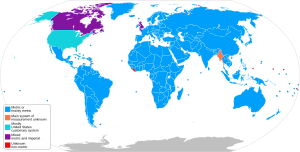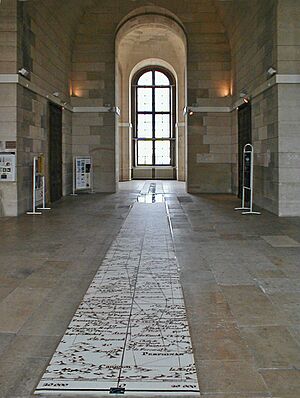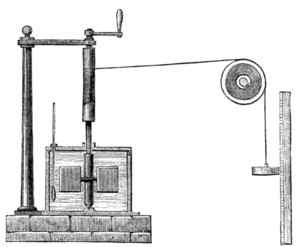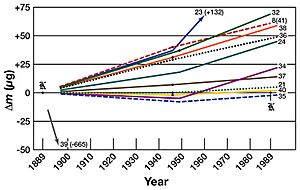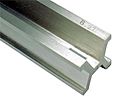History of the metric system facts for kids
The story of the metric system began a long time ago, during a period called the Age of Enlightenment. People wanted to create a system of measurement based on nature, using decimal numbers (like our number system based on 10). This new system quickly became the standard in France and then spread across Europe. Soon, other measurements were added, and the metric system became popular all over the world.
The first real version of the metric system appeared in 1799, during the French Revolution. Before this, France had many different ways of measuring things, which made trade very confusing. The new system used the kilogram for mass and the metre for length. These basic units were inspired by nature. The metre was based on the size of the Earth, and the kilogram was based on the mass of a litre of water (which is a cubic decimetre). Special copies of the metre and kilogram were made from platinum. These copies were the official standards for the next 90 years. Even though people didn't like the metric system at first, France and much of Europe fully adopted it by the 1850s.
In the mid-1800s, a scientist named James Clerk Maxwell thought of a smart way to organize units. He suggested that a few units should be "base units," and all other units, called "derived units," could be made from these base units. Maxwell proposed three base units: length, mass, and time. Later, as people learned more about electromagnetism, new units were needed. In 1901, Giovanni Giorgi showed that a fourth base unit, for electromagnetism, was needed to make the system work perfectly.
In 1875, an important agreement called the Treaty of the Metre was signed. This treaty led to new, very precise metre and kilogram standards. It also created an international group called the Conférence générale des poids et mesures (CGPM), which means General Conference on Weights and Measures. This group was set up to manage the new system of weights and measures.
In 1960, the CGPM officially launched the International System of Units (known as SI). It started with six "base units": the metre, kilogram, second, ampere, kelvin (originally called "degree Kelvin"), and candela. Sixteen more units were derived from these. Later, a seventh base unit, the mole, and six more derived units were added. During this time, the metre was redefined using the speed of light. The second was redefined using the microwave frequency of a caesium atomic clock.
The original kilogram standard was a physical object, and it wasn't perfectly stable. So, starting in the late 1900s, scientists worked to redefine the ampere, kilogram, mole, and kelvin. They wanted to base these units on unchanging constants of physics. This led to the 2019 redefinition of the SI base units. This change meant that we no longer needed physical objects, like the old kilogram, as official standards.
Contents
- Why We Needed a New System
- The Metric System in Revolutionary France
- Developing New Metric Systems
- The Metre Convention
- Measurement Systems Before World War II
- Developing the SI: The "Practical System"
- The International System of Units (SI)
- Modern SI Evolution
- Redefining with Fundamental Constants
- See also
- Images for kids
Why We Needed a New System
For a long time, people used many different ways to measure things. This caused a lot of problems, especially when countries traded with each other.
Old Ways of Measuring
In the early 800s, the Emperor Charlemagne tried to make measuring units the same across his empire. But as his empire broke apart, these standards changed again. In England, the Magna Carta (1215) also tried to set standard measures for things like wine and cloth.
Back then, people in Europe used Roman numerals (like I, V, X). But in other parts of the world, like among the Arabs, they used a system with ten symbols (0, 1, 2, etc.) that we use today. Around 1202, a mathematician named Fibonacci introduced this number system to Europe. This made it easier to work with numbers.
In 1586, Simon Stevin helped make the decimal system popular in Europe. He wrote a small book called De Thiende ("the tenth"). This book helped create the way we write decimal numbers today. Stevin believed that using decimals for money, measurements, and weights would become common everywhere.
Problems with Old Standards
For centuries, the standard for length was often based on body parts, like the length of a man's outstretched arms. An iron bar was made to represent this length, called a toise. But this iron bar had problems: it rusted, got stolen, bent, or even got lost. When a new standard was made, it was often slightly different. This meant there were many different "standard" lengths, which was confusing. People started looking for a better, more reliable standard based on something in nature.
Clocks and Pendulums
In 1656, Christiaan Huygens invented the pendulum clock. This led to ideas about using the length of a pendulum that swung once per second as a standard unit. However, scientists soon found that pendulums of the same length would swing at different speeds in different places. This was because of small changes in gravity. So, a pendulum wasn't a good universal standard.
In 1670, a French astronomer named Gabriel Mouton suggested a decimal system for length. He thought it should be based on the size of the Earth. He proposed that a unit called the milliare would be one minute of arc along the Earth's meridian (an imaginary line from the North Pole to the South Pole). He also suggested dividing units by ten, like we do with decimals. Mouton's ideas interested other scientists, who also thought about linking a standard length to a pendulum's swing.
Measuring the Earth
Since the Middle Ages, people thought the Earth was a perfect, unchanging sphere. So, it made sense to use a part of its surface as a standard for length. But first, they needed to measure the Earth accurately.
In 1669, Jean Picard, a French astronomer, was the first to measure the Earth's size very precisely. He made only a tiny error of 0.44%. Later, Isaac Newton explained that the Earth isn't a perfect sphere; it bulges at the equator. This also explained why pendulums swung differently in different places.
The Push for a Global System
By the mid-1700s, it was clear that countries needed to agree on standard weights and measures, especially for trade and science. In 1783, the British inventor James Watt (who invented the improved steam engine) asked for a global decimal measurement system. He suggested a system that linked length and mass using the density of water. In 1788, the French chemist Antoine Lavoisier also used a decimal system for his experiments.
In 1790, France suggested to Britain and the United States that they create a common unit of length, a "metre," based on a pendulum that swung once per second. But they couldn't agree on where to define it, because gravity changes with location. Each country wanted the definition to be based on their own land. Because they couldn't agree, France went ahead and developed the metric system on its own. Britain later adopted the Imperial System, and the United States kept its old British measures. This difference lasted for nearly 200 years.
The Metric System in Revolutionary France
Confusing Old Measures
Before the French Revolution in 1789, France had about 800 different units of measure. These units could have up to 250,000 different definitions! For example, a "foot" could be a different length in every town, and even for different types of trade. This made it easy for people to cheat and made trade and industry very difficult.
Defining the New Units
In 1790, a group of five top French scientists was asked to create a new system. These scientists included Joseph-Louis Lagrange and Pierre-Simon Laplace. They suggested a system that used decimals. The unit of length would be based on a part of the Earth's meridian, and the unit of mass would be based on a cube of water. The French Assembly approved these ideas in March 1791.
The scientists decided that the new measure of length, the metre, should be exactly one ten-millionth of the distance from the North Pole to the Equator, measured along the Paris meridian.
They also decided that the unit of mass, the "gramme," was too small for everyday use. So, they added the prefix "kilo" to make the "kilogramme." This is why the kilogram is the only SI base unit that has a prefix in its name. A temporary kilogram standard was made. They also worked to find the exact mass of a cubic decimetre (which is now called a litre) of water.
On April 7, 1795, the metric system became official French law. It defined six new decimal units:
- The mètre, for length (one ten-millionth of the distance from the North Pole to the Equator through Paris).
- The are (100 square metres) for land area.
- The stère (1 cubic metre) for the volume of firewood.
- The litre (1 cubic decimetre) for liquid volumes.
- The gramme, for mass (the mass of one cubic centimetre of water).
- The franc, for currency.
- Note: Only the metre and kilogram became part of later metric systems. Litres and hectares are still used, but they are not official SI units.
They also created prefixes for multiples and submultiples: "myria-" (10,000), "kilo-" (1000), "hecto-" (100), "deka-" (10), and "deci-" (0.1), "centi-" (0.01), and "milli-" (0.001).
Measuring the Meridian
The job of surveying the meridian arc (the line from Dunkirk to Barcelona) was given to Pierre Méchain and Jean-Baptiste Delambre. This task was supposed to take two years, but it ended up taking more than six years (1792–1798). There were technical problems and delays because of the French Revolution. The Paris meridian was chosen because it was a good scientific choice, with parts at sea level and in the middle of the Earth's curve.
Delambre measured the northern section (about 742.7 km) from Dunkirk to Rodez Cathedral. Méchain measured the southern section (about 333.0 km) from Rodez to Barcelona. Delambre used a 10 km baseline near Melun, measured with four platinum rods. Méchain had a similar baseline near Perpignan. After they finished, they checked each other's work. They then calculated the metre to be slightly shorter than the temporary value. On November 15, 1798, they returned to Paris with their data. The final value of the mètre was set in 1799 based on their survey.
The French Metric System Takes Hold
In June 1799, new platinum standards were made based on the measurements. The mètre des archives (archive metre) and the kilogramme des archives (archive kilogram) were placed in the French National Archives. In December of that year, the metric system officially became the only system of weights and measures in France, starting in 1801.
However, people still used the old measures. In 1812, Napoleon changed the law, bringing back some old names for measures but redefining them as round numbers of metric units. This was a mixed system. In 1837, after Napoleon's empire fell, the new government brought back the original metric system, making it mandatory by 1840. It took until about 1858 for France to fully switch to the metric system. Some old unit names, like the livre (now meaning 500 grams), are still used today.
Developing New Metric Systems
At the start of the 1800s, the French standards for length and mass were the only real parts of the metric system. Other units didn't last long. Clocks had been around for 150 years, but there was no standard for time. Also, people didn't yet understand how different physical quantities, like force and electricity, were connected.
In 1861, the British Science Association (BAAS) suggested a system based on "mechanical" units: length, mass, and time. Over the next few decades, this helped connect mechanical, electrical, and heat units.
Time Measurement
In 1832, German mathematician Carl Friedrich Gauss made the first precise measurements of the Earth's magnetic field. He used a decimal system with the millimetre, milligram, and second as base units. Gauss's second was based on how fast the Earth rotated. This showed that time was a very important part of any measurement system.
Work and Energy
In 1843, James Prescott Joule showed how to measure the energy transferred when work is done. This connected the "calorie" (heat needed to raise water temperature) to mechanical work. Energy became a key idea in science, linking heat, motion, and later, electricity.
The First Organized Metric System: CGS
In 1861, a committee of the British Science Association (BAAS), including famous scientists like Lord Kelvin and James Clerk Maxwell, started looking into electrical resistance. They decided to use the metric system and make sure electrical energy units matched mechanical energy units. In 1863, they introduced the idea of a "coherent system" where length, mass, and time were "fundamental units" (now called base units). All other units could be derived from these. They chose the centimetre, gram, and second as base units. This became known as the cgs system of units.
In 1861, Charles Bright and Latimer Clark suggested naming electrical units after scientists like Georg Ohm (ohm), Alessandro Volta (volt), and Michael Faraday (farad). This idea was supported and later used for many other units.
In 1873, another BAAS committee recommended using the cgs system. They also suggested "dyne" for force and "erg" for energy. The cgs system was used for scientific work for the next 70 years.
Electrical Units
It was hard to fit electrical units into the mechanical system. Different systems were created.
- Electromagnetic (EMU) System: Based on André-Marie Ampère's discovery about forces between electric currents. Units were called abampere, abvolt, etc.
- Electrostatic (ESU) System: Based on Coulomb's law about forces between charged objects. Units were called statampere, statvolt, etc.
- Gaussian System: Heinrich Hertz realized that EMU and ESU units were related by the speed of light. He suggested combining them, using EMU for magnetic things and ESU for other electrical things. This system is useful in theoretical physics.
The CGS units were not practical for engineering. So, a "practical" system was developed, later called the quad–eleventhgram–second (QES) system. Its electrical units were scaled to be more useful. This system became the International system in the late 1800s.
The Metre Convention
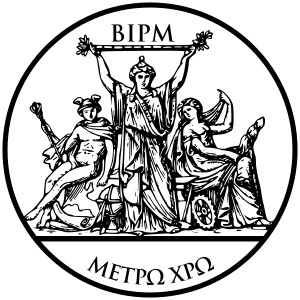
As more countries used the metre, problems with the original mètre des Archives became clear. Countries bought copies, but there was no way to be sure they were all exactly the same. The original definition based on the Earth's meridian was too hard to use for everyday checks. Also, the original metre was an "end standard" (the bar itself was one metre long), which could wear down with use.
In 1867, people suggested creating a new international standard metre. This new standard would be a "line standard," meaning the metre was the distance between two lines marked on a bar. This avoided wear and tear. The French government helped set up an International Metre Commission, which met in Paris in 1870 and 1872 with about 30 countries.
On May 20, 1875, 17 countries signed the Metre Convention. This treaty created three important organizations:
- The Conférence générale des poids et mesures (CGPM), the main authority for all decisions.
- The Comité international des poids et mesures (CIPM), a group of scientists who prepare and carry out CGPM decisions.
- The Bureau international des poids et mesures (BIPM), a permanent lab that keeps the main standards and compares national standards.
The international prototype of the metre and international prototype of the kilogram were made from a very strong mix of 90% platinum and 10% iridium. These materials are very hard and conduct electricity and heat well. The metre prototype had a special X-shape to make it more stable. The kilogram prototypes were cylindrical. A company in London made 30 metre prototypes and 40 kilogram prototypes. In 1889, at the first CGPM meeting, bar No. 6 and cylinder No. X were chosen as the international prototypes. The others were kept as copies or given to member countries.
After the Metre Convention, the BIPM was in charge of the metre and kilogram. Other units were managed by other groups. In 1901, the CGPM clarified that the kilogram was a unit of mass, not weight. The original 40 kilogram prototypes were added to over time for new countries joining the Convention.
In 1921, the Metre Convention was expanded to include electrical units.
Measurement Systems Before World War II
The 1900s saw five main periods in measurement history: 1. The 1901 definition of the MKS system. 2. 50 years where MKS, CGS, and old systems were all used. 3. The 1948 "Practical system of units" (a step towards SI). 4. The introduction of SI in 1960. 5. The ongoing changes to SI in the later half of the century.
A Coherent System
In 1901, Giovanni Giorgi realized that to make a complete system, a fourth base unit for electricity (like the ampere) was needed. This meant that constants related to electricity and magnetism would have physical dimensions. His work also showed the importance of energy, with the joule as the unit of energy. However, it took over 30 years for Giorgi's ideas to be fully accepted.
Measurement Systems in Industry
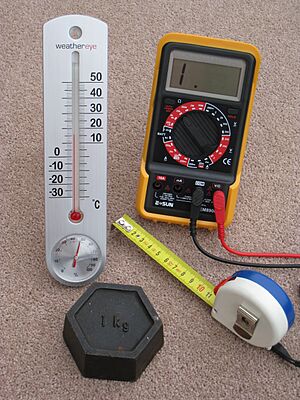
As industries grew worldwide, the cgs system was the main measurement system for about 60 years. It had many derived units, which was helpful. The MKS system didn't have a defined unit for electromagnetism. Also, traditional measurement systems were still strong in the United States, Britain, and even in France. Wars and politics also slowed down the development of a single, unified system.
In 1933, the CGPM decided to replace the "international" electrical units with "absolute" ones. They accepted Giorgi's system (MKSX) but didn't pick the fourth base unit. In 1935, J. E. Sears suggested it should be the ampere, but World War II delayed this until 1946.
Between 1921 and 1936, the national metre standards were compared to the international prototype. This showed that the metre's definition was very stable. The way the prototype metre should be measured was also made clearer.
Developing the SI: The "Practical System"
The 9th CGPM meeting in 1948 was important. Scientists asked for a single, practical system of units for all countries. The CIPM (International Committee for Weights and Measures) suggested a major update to the metric system, based on the MKS system.
They set the second based on astronomical observations from the year 1900. The ampere was accepted as the electromagnetic base unit, as Giorgi had suggested. They also proposed two more base units: the degree kelvin and the candela. For the first time, the CGPM made recommendations for derived units. They also set rules for writing unit symbols and numbers.
Time
Before atomic clocks, the Earth's rotation was the most reliable way to keep time. But scientists found that the Earth's rotation was slowing down. In 1956, the CGPM asked the CIPM to define the second. In 1958, they defined the "ephemeris" second based on the Earth's rotation speed in 1900.
Electrical Unit
Following Giorgi's ideas, the CIPM recommended that the ampere be the base unit for electromechanical units. The old definitions for the ohm and volt were dropped, and these units became derived from the ampere. In 1946, the CIPM formally adopted a definition of the ampere. The definitions for the absolute electrical system, based on the ampere, became official in 1948.
Temperature
The Celsius temperature scale was created in the 1700s, with water freezing at 0 °C and boiling at 100 °C. In 1948, the CGPM renamed the "degree Celsius" to "degree Celsius". They also set the triple point of water (where water, ice, and steam exist together) as 0.01 °C. Later, the name "Kelvin" was given to the absolute temperature scale, and the triple point of water was defined as 273.16 K.
Luminosity
Before 1937, there were different national standards for light intensity. The International Commission on Illumination (CIE) and the CIPM created a new standard called the candela (cd). This was approved by the CGPM in 1948.
Derived Units
The new definition of the ampere allowed for clear definitions of many electrical units like the farad, henry, watt, tesla, weber, volt, ohm, and coulomb. Other derived units included the lux and lumen (based on the candela), and the degree Celsius (equal to the degree Kelvin). Other units like the radian, steradian, hertz, joule, and newton were also part of the proposal.
The International System of Units (SI)
In 1952, the CIPM suggested using the wavelength of a specific light source to define length. In 1960, the CGPM accepted this idea, using light from a krypton 86 atom as the new standard for the metre. The old metre artifact was no longer needed.
In 1960, Giorgi's ideas became the foundation of the Système International d'Unités (International System of Units), or SI. This first version of SI had six base units: the metre, kilogram, second, ampere, degree Kelvin, and candela. It also had sixteen derived units.
Modern SI Evolution
Since 1960, the SI has added a seventh base unit, the mole, and six more derived units: the pascal for pressure, the gray, sievert, and becquerel for radiation, the siemens for electrical conductance, and katal for catalytic activity. Many units have also been redefined using physical constants.
New Base and Derived Units
The mole was added in 1971. It was originally known as a gram-atom or gram-molecule. There used to be different definitions for atomic weight between chemists and physicists. But in 1959/60, they agreed to define the atomic weight of carbon-12 as exactly 12 atomic mass units. This agreement led to the mole becoming a base unit in SI.
Moving to Constant Definitions
A big change in the modern SI was defining units based on unchanging physical constants of nature.
In 1967, the "degree Kelvin" (°K) was renamed the "kelvin" (K).
In 1968, the second was redefined using the frequency of radiation from a caesium 133 atom. This was a much more precise way to define time than using the Earth's rotation.
By 1975, with the second defined by a physical phenomenon, the CGPM allowed the CIPM to explore using the speed of light to define the metre. This idea was accepted in 1983.
The candela's definition was also updated in 1979. Instead of a specific light source, it was defined by the power of a specific frequency of yellowish-green light, which is where the human eye sees best.
Kilogram Artifact Instability
After the metre was redefined in 1960, the kilogram was the only SI base unit still defined by a physical object. Over the years, the various national copies of the kilogram were checked against the international prototype of the kilogram (IPK). In 1988–1989, a check showed that the average difference between the IPK and the national copies was 50 micrograms. It was hard to tell if the IPK was losing mass or if the national copies were gaining mass. This showed that a physical object was not the best long-term standard.
New Ideas for the Kilogram
Scientists proposed several ways to replace the IPK. The International Avogadro Project worked on making a 1 kg sphere from a perfect silicon-28 crystal. The idea was that this sphere could be precisely remade from its exact specifications, unlike a physical artifact that could change.
Other ideas included defining the kilogram using the Watt balance, which relates mass to electrical and mechanical power.
Eventually, the decision was made not to create any new physical object to define the kilogram. Instead, all SI units would be defined by setting exact values for several fundamental physical constants.
Redefining with Fundamental Constants
In 2007, the CGPM asked the CIPM to look into using natural constants as the basis for all units, instead of physical objects.
This idea was supported by other science groups. In 2010, a plan was made to change the SI definitions. The CIPM decided that the conditions weren't fully met yet, but they agreed to the new definitions in principle.
In the new definitions, four of the seven SI base units—the kilogram, ampere, kelvin, and mole—were redefined. This was done by giving exact numerical values to the Planck constant (h), the elementary electric charge (e), the Boltzmann constant (kB), and the Avogadro constant (NA). The second, metre, and candela were already defined by physical constants, but their definitions were updated. The goal was to make the SI better without changing the actual value of any units, ensuring that existing measurements still worked.
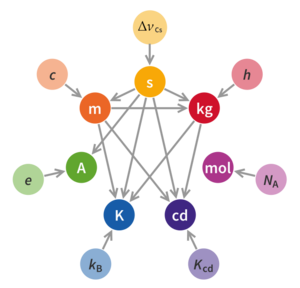
This plan was accepted. In 2014, it was decided that more data was needed before the changes could be made. Finally, in 2017, enough accurate measurements were available. The redefinition was adopted at the 26th CGPM meeting in November 2018. The changes officially came into force in 2019. This created a system of definitions that is expected to be stable for a very long time.
See also
 In Spanish: Historia del sistema métrico para niños
In Spanish: Historia del sistema métrico para niños
Images for kids
-
James Watt, a British inventor who wanted a global decimal measurement system.


